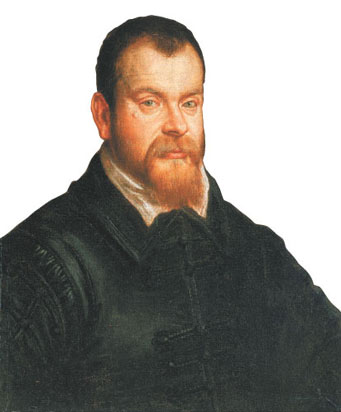
Portrait of Galileo Galilei, from the National Maritime Museum, London
S&T
Imagine the thrill of looking through a telescope and making a new discovery as soon as you peer into the eyepiece. Although spotting some never-before-seen celestial object can happen, it’s rare these days because so many professional and amateur astronomers are combing the sky every night. But four centuries ago the telescope was a revolutionary new invention, and when the great scientist Galileo Galilei first pointed a telescope skyward in late 1609, he was astounded by what he saw night after night. All the unexpected sights revealed through his instrument transformed his life and the world at large.
You can follow the same path as Galileo Galilei, observing the same celestial sights that he did — from craters on the Moon to the miniature solar system encircling Jupiter. As you “rediscover” some of the night sky’s many marvels, you’ll gain skill as an observer and get an appreciation for the profound insights revealed to Galileo’s inquisitive eyes.
Before the telescope came along, most educated people still accepted concepts about the universe first popularized by Aristotle and his contemporaries in the 4th century BC. In their view, Earth sat motionless at the center of the universe, with the Sun, Moon, planets, and stars affixed to nested crystalline spheres like the layers of an onion. The spheres spun at various rates, such that the Sun completely encircled Earth in just one day while the stars took an entire year. And, unlike earthly matter, the spheres and all they contained consisted of a perfect, changeless, and eternal “aether.” In the 2nd century AD, the influential astronomer-geographer Ptolemy introduced an even more elaborate crystalline-clockwork scheme that prevailed unchallenged for nearly 1,500 years.
It takes a bit of imagination, but look up at the night sky and think about how it must have appeared to people who lived before Galileo. Try to see the stars not as distant suns, but as points of light shining from the edge of the universe. Imagine the planets as perfect bits of aether instead of worlds with moons of their own.
Of course, not everyone accepted the ideas of Aristotle and Ptolemy. In 1543 Nicholas Copernicus published a fundamentally different concept that placed the Sun at the center of the universe with Earth and other planets moving in orbits around it. It was a radical departure — most authorities continued to accept the Ptolemaic system.
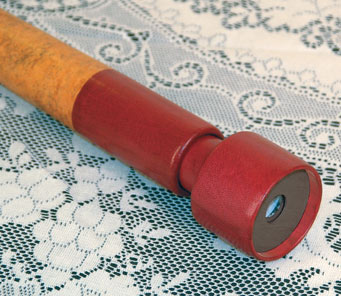
Only two of Galileo”™s many telescopes survive. Shown here is the skyward end of a museum-grade replica that, once completed, will be displayed at Griffith Observatory in Los Angeles.
Steven A. Simpson
But all that would eventually change. In October 1608 a Dutch eyeglass maker named Hans Lipperhey filed a patent application for an invention he called a kijker (“looker”). It was a tube with a convex lens in the front and a concave lens at the eyepiece end, a combination that made distant objects appear much closer. Several months later news of Lipperhey’s invention reached Galileo in Italy, who quickly fashioned an instrument of his own. In August 1609 Galileo presented the Venetian Senate with an 8-power telescope. Impressed, the senators doubled his salary and guaranteed his job for life!
The newly promoted professor then made a 20-power telescope for his own use and began studying the night sky in October or November. By contrast to modern refracting telescopes, Galileo Galilei's instrument was not very capable. Its front lens was only 37 mm (1½ inches) in diameter, and the field of view was restricted to 15 inches at 100 yards — much narrower than most instruments now. Still, this modest telescope was good enough to make discoveries as important as any in the history of astronomy.
As most new stargazers do, Galileo began by studying the Moon.
Lunar Landscape
Step outside to gaze at the next full Moon, and try to forget all the photographs you’ve seen of the lunar landscape. To Galileo Galilei's contemporaries, the Moon appeared to be a perfect sphere. The mottled gray patterns, they imagined, were areas of different densities.
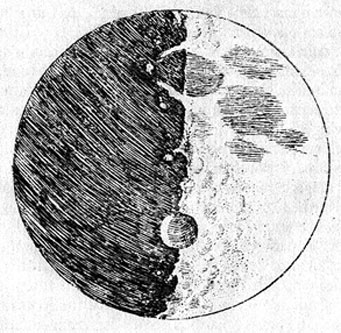
Galileo published his first telescopic observations in The Sidereal (Starry) Messenger (1610). His sketch of a first-quarter moon, shown here, called attention to the details visible along the day-night terminator. The prominent crater below center, which he probably drew overly large for emphasis, is most likely the one known today as Albategnius, 71 miles across.
S&T
Now think about that as you look at the Moon through binoculars or a telescope. The view is most impressive along the terminator, the line separating day from night, where long shadows make it easier to see the terrain. When Galileo looked at the terminator, he realized that the lunar landscape is a jumble of mountains, valleys, and craters — visual proof that the Moon’s face was far from perfect.
Galileo continued to view the Moon night after night, following the progress of the terminator as it swept across the landscape and sketching what he saw so he could share his discoveries with others. Sketching what you observe is still a good idea: trying to record what you see accurately teaches you to perceive more details whenever you look.
Galileo’s drawings conveyed the jagged nature of the Moon’s terrain, and one sketch in particular exaggerated the prominence of a single lunar crater straddling the terminator, most likely the one now called Albategnius. The best time to look for Albategnius is when the Moon’s phase is around first or last quarter.
Jupiter’s Revelations
After the Moon, the most alluring objects in the night sky are planets. Jupiter shone brightly in the evening sky when Galileo began observing, so it was an obvious target for his telescope. You should have no difficulty finding Jupiter either — during summer it’s in the southern part of the sky after sunset, and on the moonless evenings nothing else is brighter. Use the Sky & Telescope sky charts in our latest issues or sky charts from our store if you’re unsure about where to look.
Even a small telescope shows that Jupiter is truly a world, not just another starlike pinpoint of light. Jupiter also comes with “extras”: its four largest moons are relatively bright and easy to spot. Their positions shift noticeably as they move around Jupiter, and because their orbits are edge-on from our perspective, they form a more-or-less straight line running east to west.

When Galileo first viewed Jupiter through a telescope — on January 7, 1610, he discovered that the planet was accompanied by three "stars" in a line. Imagine his surprise the next night, when he found that the trio had shifted in position. On later nights he spied a fourth moon as well.
The Sidereal Messenger
At first, Galileo Galilei believed that the four pinpoints of light near Jupiter were simply background stars. However, his nightly observing sessions soon revealed that they shifted in position but never strayed far from the planet (illustrated in the image at right). Galileo realized he was tracking four moons. Nothing in the teachings of Aristotle or Ptolemy could account for Jupiter’s companions, and Galileo quickly deduced that he’d found new evidence for Copernicus’s theory. Showing that Jupiter and its system of moons orbit the Sun together made it easier to accept that the Earth and Moon do, too. (Critics of Copernicus had claimed that if Earth were in motion it would eventually leave the Moon behind.) Galileo wrote:
"Here we have a fine and elegant argument for quieting the doubts of those who, while accepting with tranquil mind the revolutions of the planets about the Sun in the Copernican system, are mightily disturbed to have the moon alone revolve about the Sun. Some have believed that this structure of the universe should be rejected as impossible. But now we have not just one planet rotating about another while both run through a greater orbit around the Sun; our eyes show us four stars which wander about Jupiter as does the moon around the earth, while all together trace out a grand revolution about the Sun in the space of twelve years."
Today, you likely own a telescope powerful enough to reveal far more detail than Galileo ever saw. At magnifications as low as 50×, you can see two dark bands of clouds girding Jupiter’s midsection. If your timing is right and the air above you is steady, you might even glimpse the hurricane-like oval called the Great Red Spot. Galileo apparently couldn’t see Jupiter’s cloud bands, which weren’t discovered until others reported seeing them a generation later, in 1664.
We know that Galileo Galilei also observed Saturn. But his telescope wasn’t powerful enough to reveal the planet’s rings for what they truly are: a thin, flat disk of small particles. Initially he thought the rings were two separate bodies alongside Saturn. And in 1612, when the ring system was oriented edge-on as seen from Earth, he was convinced that they had disappeared entirely. “I do not know what to say in a case so surprising, so unlooked for, and so novel,” he wrote.
There’s no evidence that Galileo saw the then-undiscovered planet Uranus, but his sketches prove that he saw Neptune in the vicinity of Jupiter and mistook it for a star. Neptune moves slowly in its orbit, taking nearly 165 years to complete one trip around the Sun. The apparent motion of the outer planets among the stars slows to a stop and even reverses at predictable times each year, and Neptune wasn’t drifting noticeably when Galileo saw it. If he’d watched it a bit longer, he’d surely have noticed its motion and realized it wasn’t a star.
The Phases of Venus
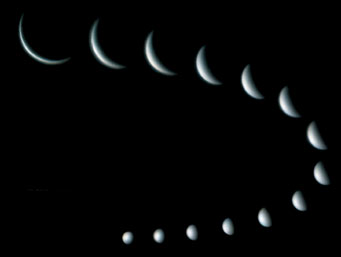
From Earth's perspective, Venus completes an entire cycle of phases in 19 months. With a backyard telescope and a magnification of at least 50×, you can watch Venus slowly change appearance from week to week.
S&T
By December 1610, Galileo Galilei had already published Sidereus Nuncius (The Sidereal Messenger), an account of his initial telescopic observations, and was continuing his reconnaissance of the known solar system. He next took aim at Venus, which was then blazing brightly in the evening sky.
If you’re observing during May and June (when this article was first published) you’ll have to get up early to spot Venus. In those months the planet sits low in the east just before dawn. You might find Venus a disappointing subject for observation through a telescope — it’s shrouded in thick clouds that hide all details of the surface.
But the most important thing to notice is that the planet’s disk is not perfectly round. Instead, it looks like a tiny elongated football, mimicking a gibbous Moon. Watch carefully over the next few weeks, and you’ll see the disk getting fuller (more circular) and smaller. Those changes confirm an especially important discovery made by Galileo: Venus goes through phases, just like the Moon, and this cycle of change proves that it must be orbiting the Sun.
If you imagine the motion of Venus as explained by Copernicus, you can visualize how it should appear from Earth. Depending on its position relative to the Sun, Venus can look like a crescent, a semicircle, or a full globe. The planet appears biggest during its crescent phase (when it’s between Earth and the Sun) and smallest when full. The shape is especially easy to see when Venus displays a thin, bright crescent.
Truth and Consequences of Galileo Galilei's Wanderings
As you retrace the steps Galileo Galilei took in his wanderings around the night sky, it’s worth thinking about the effect his observations had 400 years ago. The Sidereal Messenger was a sensation, transforming Galileo into a scientific celebrity and sparking public interest in telescopes and astronomy. He used this opportunity to curry favor with the rich and powerful Medici family, dedicating the book to Grand Duke Cosimo II de Medici and naming the moons of Jupiter “Medician stars.” Flattered, the Grand Duke appointed Galileo his chief physicist, subsidized his work, and protected him from critics.
The telescope enriched and transformed Galileo’s life in way he could not have imagined on the night he first pointed it toward the sky. Yes, he endured a harrowing clash with church officials, who ultimately convicted him of heresy for promoting Copernican theory. But that happened 22 years after publication of The Sidereal Messenger, and in the interim Galileo repeatedly capitalized on his famous discoveries and built the scientific legacy we remember today.
Perhaps you too have been (or will be!) personally transformed by a first look at Jupiter, the lunar landscape, or the crescent Venus through a telescope. For some of us, the telescope sparks a lifelong interest in science. For others, it ignites a passion for discovery and knowledge. And for most everyone, it offers a keener appreciation of the universe and our place in it.
Observing the heavens changed Galileo’s life profoundly. If you follow in his footsteps and join the observing tradition he started four centuries ago, it will change your life, too.
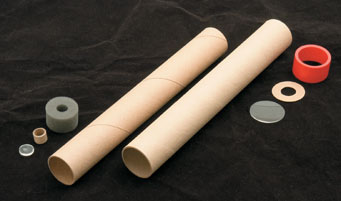
Learning Technologies' kit for constructing a 16× refracting telescope using low-plastic lenses for $9.
Craig Michael Utter
Build a Galilean Telescope!
Making a working replica of Galileo’s telescope is the best way to appreciate the accomplishments of this great observer. It’s an easy, affordable project that provides a good introduction to optics. Modern suppliers don’t offer perfect matches for the lenses that Galileo used, but it’s possible to get a pair that are nearly so for less than $50. For the objective, you’ll want a convex lens with a diameter of no more than 40 mm and a focal length of about 1,000 mm; for the eyepiece, choose a concave lens with a focal length of about –50 mm. Used together, these will yield a magnification of roughly 20×.
Once you have suitable lenses, you’ll need something to mount them in. You can use nested cardboard mailing tubes with plastic end caps, or for something sturdier try PVC plumbing parts. Either way, spray the inside of your tubes with flat-black paint to reduce internal reflections and increase contrast.
Securely mount the objective lens in the wider, outer tube and the eyepiece lens in the inner tube. You can try to improvise lens holders using plumbing gaskets, hardware bushings, or auto parts. Otherwise, use a hobby knife to make cardboard disks sized to hold the lenses. Then shim the drawtube until it slides smoothly. Duct tape provides the perfect shim material.
Galileo Galilei sometimes wrapped his wooden telescope tubes in leather. An outer wrap of brown self-adhesive vinyl (sold in craft stores) will give your telescope a better, more accurate appearance than a simple coat of paint.
Once it’s all assembled, you’ll discover immediately that your telescope is impossible to hold steady enough while observing. It’s not clear what kind of mount Galileo himself used, so feel free to be creative. A camera tripod and rubber bands or bungee cords will certainly work, or you can simply steady the tube against a stout pole, a tree, or the corner of a building.
Jim Quinn’s footsteps can be found all over his backyard in North Canton, Ohio. He’s a freelance writer associated with the National Inventors Hall of Fame in nearby Akron. This article first appeared in the May/June 2006 issue of Night Sky.
 0
0









Comments
You must be logged in to post a comment.